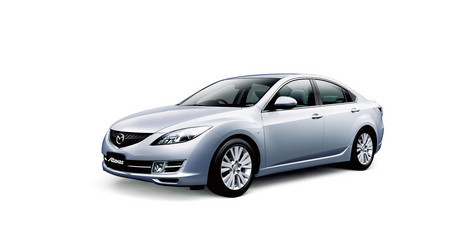Luxury, off-road, budget cars fall under ‘midsize’
2010 ACURA RL
Price range: $47,000-$55,000
Engine: 3.7-liter V-6, producing 300 horsepower and 271 pounds-feet of torque
Fuel economy: 16 mpg city / 22 mpg highway
The current generation Acura RL has largely been overlooked, and with stiff competition from cars such as the Infiniti M35, it is no surprise.
You only get one chance to make a first impression, which is one possible reason the RL has not set the automotive world on fire. When introduced, the Acura RL lacked the visual impact that its competition had. Most successful luxury flagships reflect a certain presence, one that instantly communicates its place atop the proverbial food chain. Like the current Volvo S80, the first version of the Acura RL just didn't project the size and style of a premium sedan; it had the visual feel of a "jazzed-up" Honda Accord, so many buyers never bothered to see if there was more to the RL than its plain-Jane style.
But a recent refreshening of the RL's design raised its nose; incorporated a new, chevron-shaped grille (which resembles the 'Transformers' movie logo); enlarged its headlights; broadened its shoulders; and defined its hips, along with the addition of more-prominent taillights to spice things up a bit.
As it is with first impressions, there is much more to the RL than meets the eye. Once inside, the driver and passengers are faced with a stylish, forward-sloping dash and center console, which is accented by long, arching lines. The steering wheel -- which features cruise controls, stereo and voice controls -- feels great, with buttons ideally placed.
Overall, the RL has a solid, upscale, luxury feel, but still lacks the spaciousness of other midsize cars, such as the Hyundai Genesis sedan. Speaking of the rear-wheel-drive V-8 Genesis, Acura might want to consider adding a rear-wheel-drive model to its lineup, along a V-8 power plant. For Hyundai, doing so has elevated the Genesis' status.
To Acura's credit, its engineers have developed the impressive Super Handling All-Wheel Drive system to give the RL less of a front-wheel-drive nature and more of a near, rear-wheel-drive feel. This all-wheel-drive system is so advanced that under cornering, it can transfer power to just one, two, three or four wheels in any combination -- front left and right rear, front right and rear right, etc. --giving the RL a higher-than-normal cornering ability for a mid- to full-sized sedan.
The combination of the Super Handling and the RL's 3.7 liter, 300-horsepower V-6 give it a much better feel than expected. Although the RL's power is not great, it is potent enough for most road-going situations.
The brakes were good and the ride had a nice touch of luxury, laced with good levels of performance. Those who are considering the Volvo S80 should definitely check out the Acura RL, as well; it is a hidden gem that will impress.
2010 MAZDA 6
Price range: $20,000-$30,000
Engine: 2.5-liter four cylinder, producing 170 horsepower and167 pounds-feet of torque
Fuel economy: 20 mpg city / 29 mpg highway (six-speed manual transmission)
The 2010 Mazda 6 is in one of the most competitive classes in the industry -- the contemporary sedan class. This class includes the Chevrolet Malibu, the Hyundai Sonata, the Nissan Altima, the Honda Accord, the Toyota Camry, the surprising 2010 Subaru Legacy and the excellent-looking 2010 Ford Fusion.
Unlike years past, the contemporary sedan class has more style than before. Even Toyota has improved the look of the plain-looking Camry over the previous generation's styling. On the other hand, the Mazda 6 has been known as a style leader, making improvements a bigger task. Like previous iterations of the Mazda 6, the 2010 edition has more style than most cars in its class -- only the 2010 Ford Fusion has enough style to compete with the Mazda 6's elegant looks.
When Mazda set out to design the all-new 2010 6, they instantly had a problem: Mazda wanted to create more space for people and cargo, which meant that the new 6 had to grow. Specifically, the 2010 Mazda 6 grew by 4.5 inches over the previous generation, which is problematic because a longer wheelbase tends to stymie performance, another trait for which the 6 has gained a reputation. However, one advantage is that longer wheelbases tend to yield more compliant and comfortable rides.
The 2010 Mazda 6's current character goes back to 1992 when the Amati brand was canceled. Similar to Honda's luxury Acura brand and Toyota's Lexus brand, the Amati brand was to be Mazda's high-end line. The now discontinued Millenia was to be the first of three models of this new Japanese luxury brand. When the Millenia and the entire Amati brand was canceled, it left room for the 6 to move a bit more upscale.
The 2010 Mazda 6 has the best combination of style, touches of luxury, performance and character in the contemporary sedan class. Driver and passengers are faced with a stylish, nearly luxury-class interior, featuring black lacquer trim and nickel-bright work. Compared to the excellent seats in the 2010 Ford Fusion, the leather seats in the 2010 Mazda 6 fall just a bit short.
The base Mazda 6 features a 2.5-liter four-cylinder engine that makes 170 horsepower and 167 pounds-feet of torque. Although it is not overly slow, the 170 horses did have a job on their hooves with the size of the 6. This energy was directed to the ground via a smooth-operating six-speed manual transmission.
Overall, the 2010 Mazda 6 was impressive and ranks among the top three in the midsize sedan class. Its power is not impressive, but is it is smooth and efficient. Interior appointments and comfort are clearly above average. Now the only thing that Mazda has to cover is the performance side, which should be better with the V-6 edition. If and when the MazdaSpeed 6 edition drops, the package will be complete.
2010 VOLVO XC70
Price range: $20,000-$30,000
Engine: 2.5-liter four cylinder, producing 170 horsepower and 167 pounds-feet of torque
Fuel economy: 20 mpg city / 29 mpg highway (six-speed manual transmission)
Baja California, Mexico--Palm trees swayed as a gentle ocean breeze pushed sparkling water onto the white sandy beach. The temperature of the clear ocean water was ideal and the air was a comfortable 77 degrees Fahrenheit. Like kids waiting for the toy store to open, everyone in the dining room was anxious with anticipation. Some were so excited that they couldn't even eat breakfast.
It was a perfect day for a unique test drive in a very special place -- the Baja 1000 off-road race course. After a safety briefing from legendary Baja 1000 racer Bryon Farnsworth, we hit the dirt.
Off in the distance, jagged topped mountains and flat mesas guided us towards our destination. Once signs of civilization disappeared, rocks multiplied and grew in size, while the width of the road shrank. At times, the narrow passages reminded us of cramped parking decks, flanked by boulders instead of concrete support columns and Japanese compacts. Our excursion took us over rocky, deeply rutted and sandy terrain, along with hardened salt flats.
The amazing thing about this trip was the vehicle that took us on this journey, a 2005 Volvo XC70 off-road station wagon. Yes, you did read that correctly: Our test vehicle wasn't a heavy duty off-road truck, a pre-runner or a crazy, whacked-out, militarylike SUV. And, considering that only three changes were made to the Volvo XC70 -- Pirelli Scorpion all-terrain tires, a steering cooler and an extra underbody skid plate -- this accomplishment was even more impressive.
My most recent test of the Volvo XC70 was of the all-new 2010 edition and to say that it had a lot to live up to is an understatement. While my test of the 2010 Volvo XC70 T5 was much more pedestrian than the Baja adventure that I experienced four years earlier, this is how most will be driven.
Before gas prices skyrocketed, off-road station wagons began making in-roads in traditional SUV sales.
While fuel economy is one advantage, models like the 2010 Volvo XC70 have several advantages over the traditional SUV. Since they sit lower, they have a better center of gravity than tall, rollover-prone SUVs. Typically head room is the only area that SUVs have a large advantage. Leg room and cargo space are usually about equal when compared to SUVs. For instance, the 2010 Ford Explorer has 85.8 cubic feet of cargo space, while the 2010 Volvo XC70 has 72.1 cubic feet of cargo space.
The 2010 Volvo XC70 T5 is powered by a 3.0-liter in-line six cylinder, producing 281 horsepower and 295 pounds-feet of torque. Power for the XC70 was strong and its acceleration was surprising, especially to drivers around the car. The suspension had a bit of roll at times due to its off-road set up. However, the 2010 XC70 is a nice daily commuter and better choice over the traditional SUV. The 2010 Volvo XC70 accelerates better, brakes better, is more comfortable and is more versatile in urban and suburban environments. Unless you absolutely want a traditional SUV, the XC70 is an excellent choice.
















